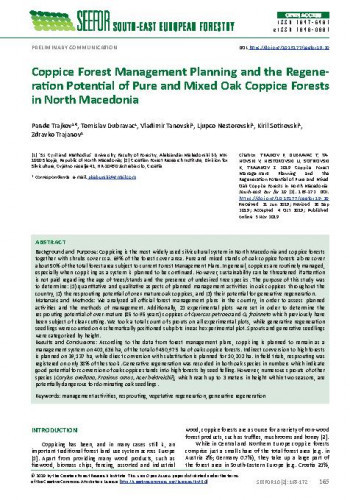Background and Purpose: Coppicing is the most widely used silvicultural system in North Macedonia and coppice forests together with shrubs cover cca. 69% of the forest cover area. Pure and mixed stands of oak coppice forests alone cover about 50% of the total forest area subject to current Forest Management Plans. In general, coppices are routinely managed, especially when coppicing as a system is planned to be continued. However, sustainability can be threatened if attention is not paid regarding the age of trees/stands and the presence of undesired tree species. The purpose of this study was to determine: (1) quantitative and qualitative aspects of planned management activities in oak coppices throughout the country, (2) the resprouting potential of over-mature oak coppices, and (3) their potential for generative regeneration. Materials and Methods: We analyzed all official forest management plans in the country, in order to assess planned activities and the methods of management. Additionally, 21 experimental plots were set in order to determine the resprouting potential of over-mature (85 to 95 years) coppices of Quercus petraea and Q. frainneto which previously have been subject of clear-cutting. We took a total count of sprouts on all experimental plots, while generative regeneration seedlings were counted on 4 schematically positioned subplots in each experimental plot. Sprouts and generative seedlings were categorized by height. Results and Conclusions: According to the data from forest management plans, coppicing is planned to remain as a management system on 401,636 ha, of the total of 450,975 ha of oak coppice forests. Indirect conversion to high forests is planned on 39,137 ha, while direct conversion with substitution is planned for 10,202 ha. In field trials, resprouting was registered on only 38% of the stools.
Sažetak

 South-east European forestry : SEEFOR : international scientific journal in field of forestry : 10,2(2019) / editor-in-chief Dijana Vuletić.
South-east European forestry : SEEFOR : international scientific journal in field of forestry : 10,2(2019) / editor-in-chief Dijana Vuletić.